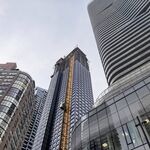Observer Walt
Senior Member
Several things come to mind.
There are major differences between suburbs built in the 1960s and 70s, and those being built in the past few years. The loopy crescents are now a thing of the past, and the grid pattern has returned. Short blocks make it possible to walk to the arterial streets, where transit can (usually) be found. Examples include Churchill Meadows in Mississauga, Velore in Vaughan, the Bur Oak section of Markham, the part of Aurora east of Bayview Avenue, etc. I think this change is now permanent.
The car dependency is less a function of the physical design of the area, and more a function of how much transit service is actually provided. This has been seen clearly in Mississauga and Brampton, and probably other suburban areas as well. When transit service is increased to a reasonable level, people will move from cars to transit, as shown in ridership statistics.
I agree that older suburban residential neighbourhoods are highly resistant to change, as pointed out above, and for most practical purposes, can't be retrofitted. But having said that, it's amazing the number of little pockets that can still be infilled (several within a short radius of my place in eastern Mississauga). The best prospects for intensification are the "avenues", as they are being called in Toronto, being the arterial streets where old, low-density developments, mainly commercial, can be redeveloped with a higher density of mixed use structures.
There are major differences between suburbs built in the 1960s and 70s, and those being built in the past few years. The loopy crescents are now a thing of the past, and the grid pattern has returned. Short blocks make it possible to walk to the arterial streets, where transit can (usually) be found. Examples include Churchill Meadows in Mississauga, Velore in Vaughan, the Bur Oak section of Markham, the part of Aurora east of Bayview Avenue, etc. I think this change is now permanent.
The car dependency is less a function of the physical design of the area, and more a function of how much transit service is actually provided. This has been seen clearly in Mississauga and Brampton, and probably other suburban areas as well. When transit service is increased to a reasonable level, people will move from cars to transit, as shown in ridership statistics.
I agree that older suburban residential neighbourhoods are highly resistant to change, as pointed out above, and for most practical purposes, can't be retrofitted. But having said that, it's amazing the number of little pockets that can still be infilled (several within a short radius of my place in eastern Mississauga). The best prospects for intensification are the "avenues", as they are being called in Toronto, being the arterial streets where old, low-density developments, mainly commercial, can be redeveloped with a higher density of mixed use structures.




